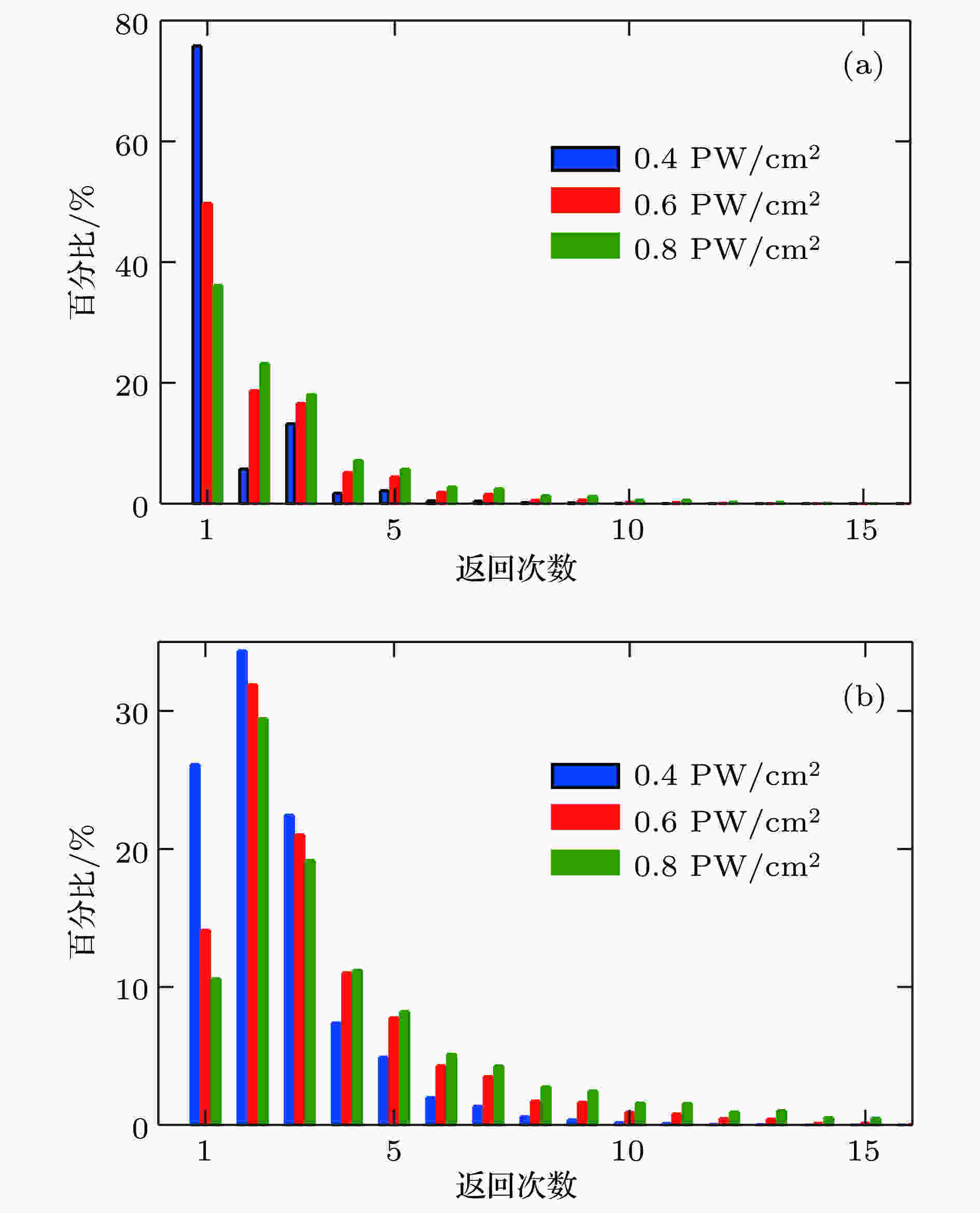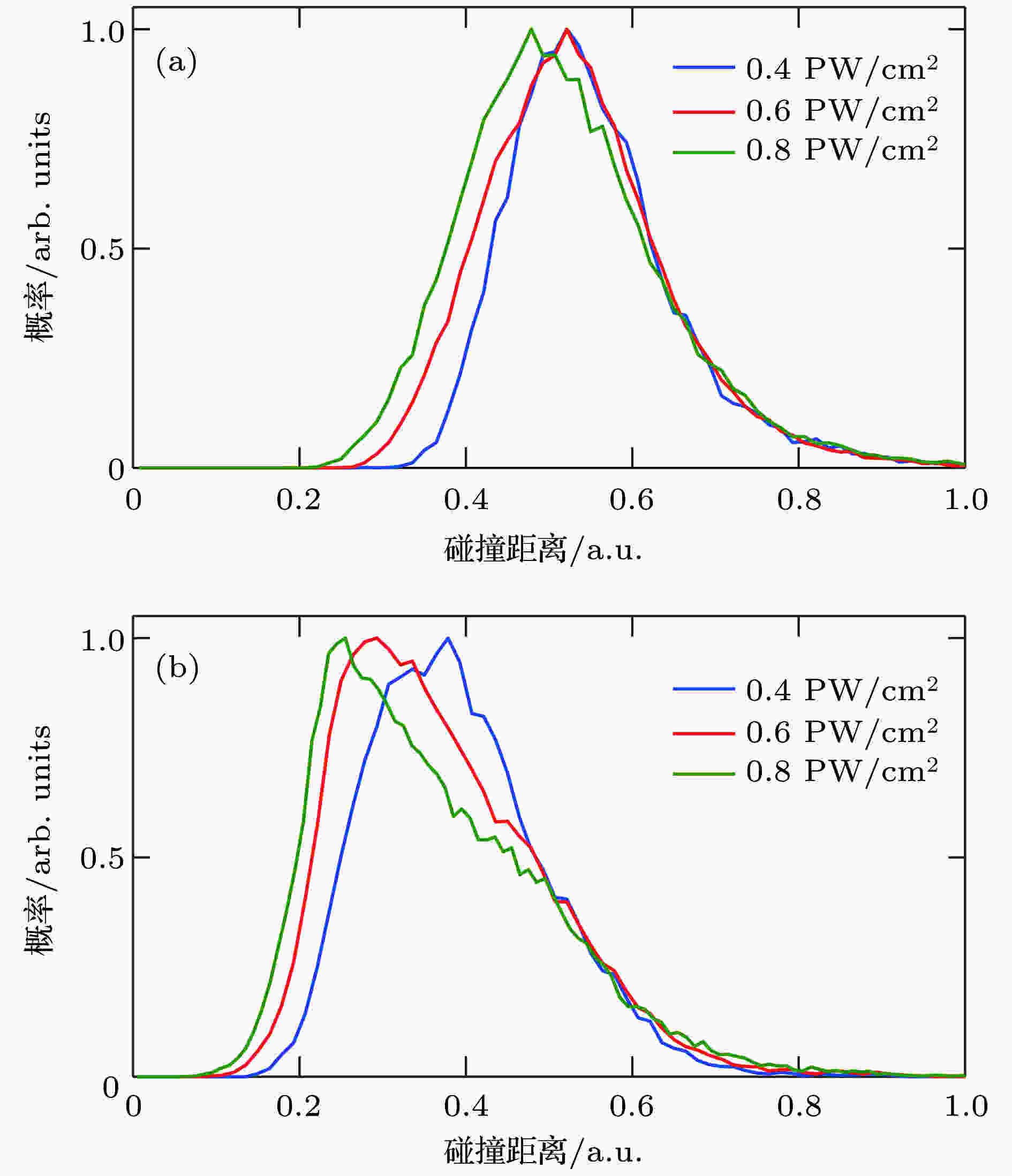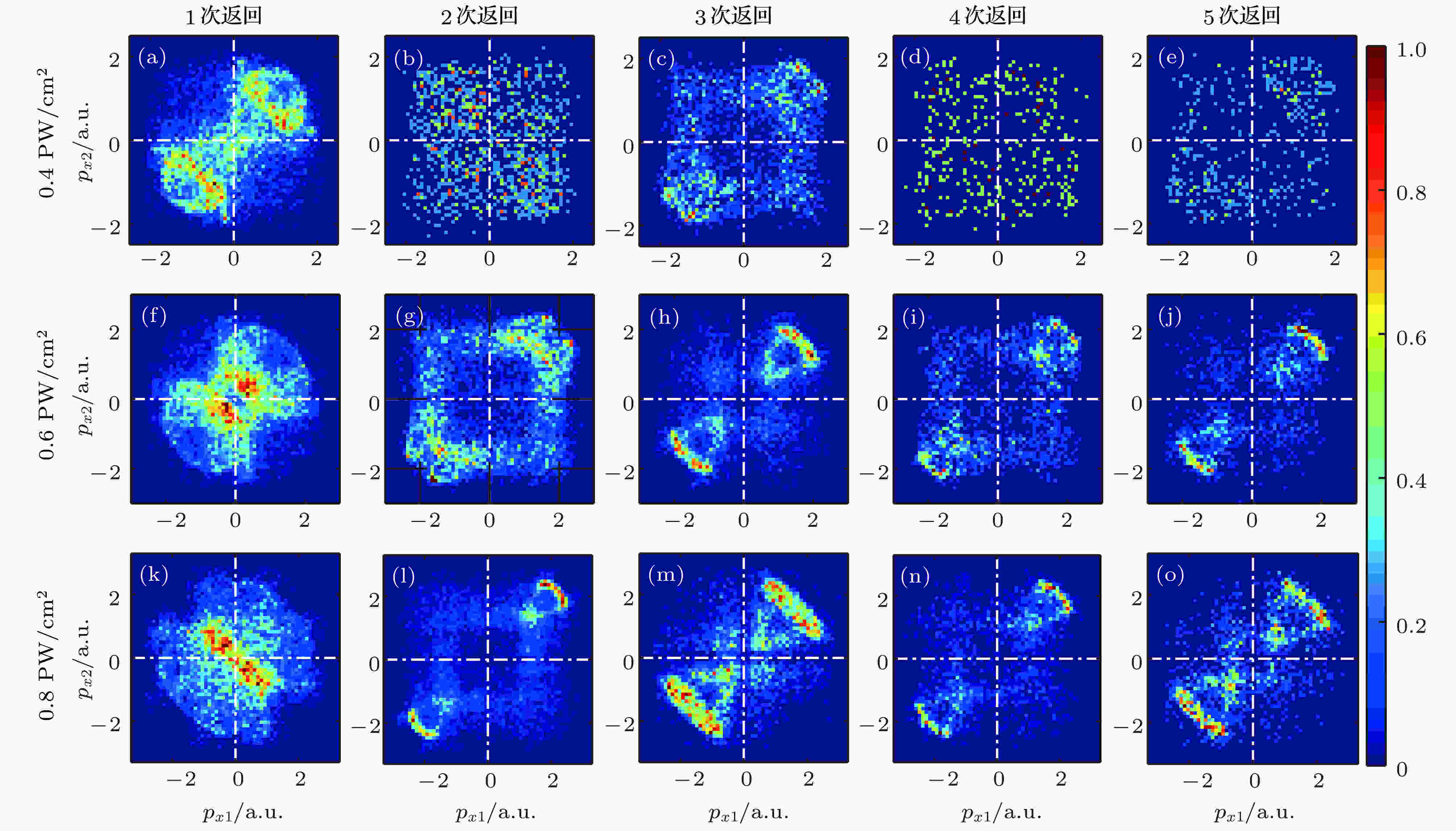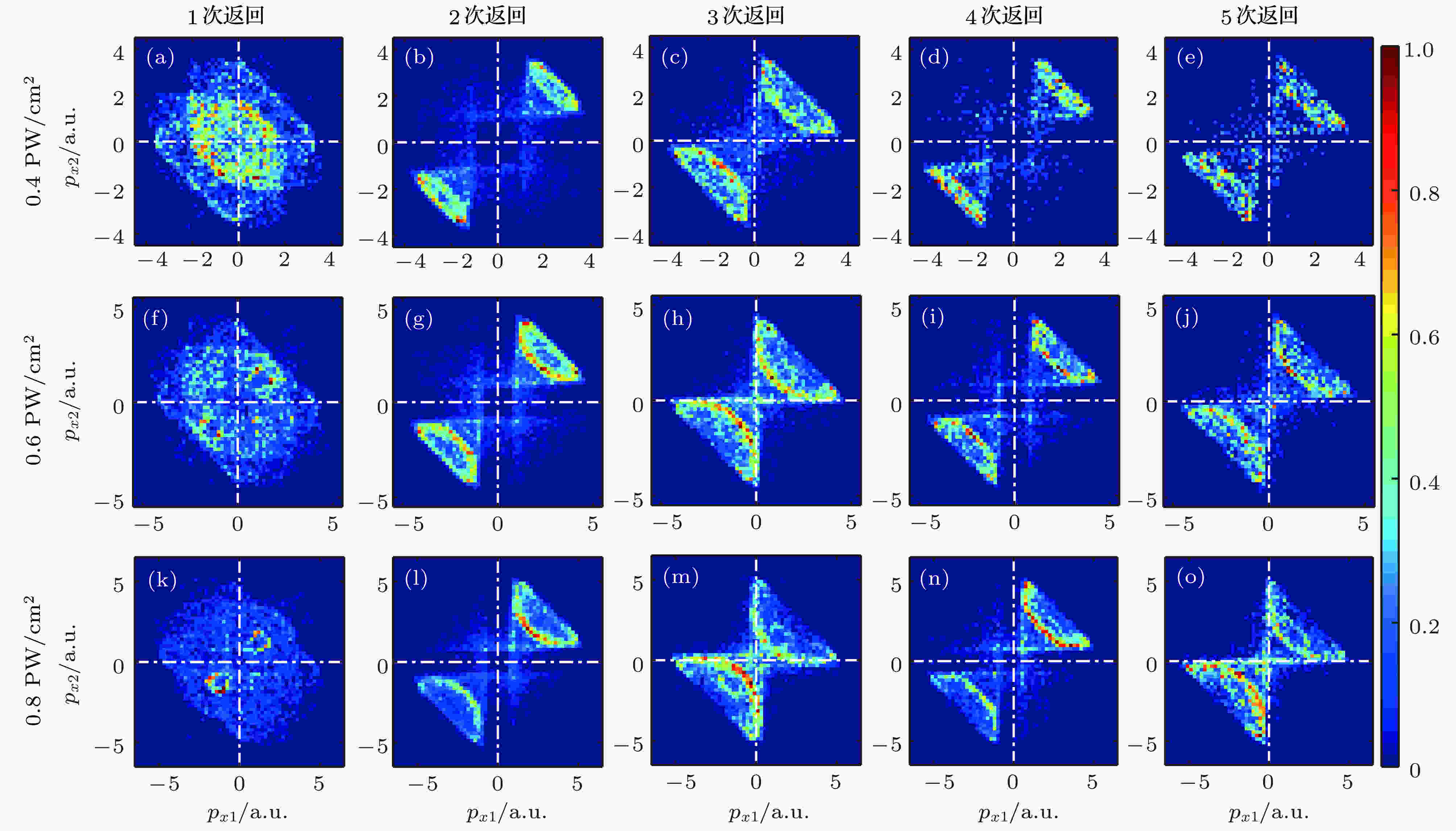全文HTML
--> --> -->近年来, 人们投入了大量的精力来研究NSDI中的电子关联及其潜在的超快动力学过程[7-14], 已经发现了许多有趣且重要的电子关联行为, 并揭示了其中潜在的微观动力学过程. 在再碰撞阈值强度以下, Ar原子NSDI的两电子动量谱呈现出反关联特性[15]. 在中等和高激光强度下, He原子NSDI的关联电子动量分布呈现出手指结构(V型结构)[16,17], 该结构反映了碰撞后母核对电子的库仑吸引、两电子之间的相互作用[18,19], 以及碰撞过程的能量分配不均[20]对NSDI中电子关联特性的影响. 对于周期量级的激光脉冲, 在低强度下NSDI的两电子动量分布呈现出平行于对角线的双线结构[21-23], 而在高强度下两电子则显示出十字架状的动量分布[24]. 实验和理论研究表明, NSDI中的两电子也存在着强烈的能量关联[25-27]. 量子模拟发现, 高强度下NSDI的电子能谱展现出一个间隔不等的干涉结构[28], 该结构被归因于长短再碰撞轨道之间的干涉. 近期, Winney等[29]利用两电子角条纹方法完成了NSDI中两电子释放时延的高精度测量. 进一步的研究表明, 一些精细的裁剪激光场, 如相位稳定的周期量级脉冲[30-36]、平行双色场[37]、正交双色场[38-40]和双色反向旋转圆偏激光场[41-43], 可以很好地操控电子的运动进而控制电子对的关联行为.
中红外激光场的实验发现, NSDI中电子对的动量分布呈现出一个近轴的V型结构[44]. 理论研究表明, 该结构源于碰撞时两电子能量分配不均, 且在中红外波段NSDI主要通过多次返回再碰撞发生[45,46]. 本文利用三维经典系综模型研究NSDI中再碰撞动力学和电子关联特性对激光强度的依赖, 采用750和1500 nm两个波长, 0.4, 0.6和0.8 PW/cm2三个激光强度. 对于750 nm, 三个强度的电子对都分布在主对角线附近, 而对于1500 nm, 随着强度的增大, 电子对从对角线向坐标轴移动, 当激光强度达到0.8 PW/cm2时, 动量分配呈现出一个近轴的V型结构. 向后分析表明, 随着激光强度的增加, 单次返回诱导的NSDI事件逐渐减少, 而多次返回事件的比例显著增加. NSDI中两电子的碰撞距离随激光波长和强度的增加而逐渐减小. 最后讨论了不同返回次数诱导的NSDI中电子对的关联特性.
在三维经典系综模型中, 两个电子遵循牛顿经典运动方程(除非另有说明, 本文均采用原子单位):




为获得系综的初始状态, 首先将两电子随机地放在核子附近. 然后给两电子一个确定的动能, 使得系统的总能量, 即两电子的势能和动能之和等于原子的第一、第二电离能之和. 本文设置总能量为?2.9035 a.u. (对应He的第一、二电离能之和). 将动能随机地分配给两个电子, 并且这两电子的速度方向随机给定. 然后两电子系统在没有激光场的情况下, 按照牛顿运动方程自由演化. 经过一段时间后(300 a.u.), 可以得到一个稳定的初始系综分布. 初始系综确定后, 原子在激光场的作用下演化, 直到激光脉冲结束, 即可得到系综中各个原子的最终状态, 包括位置和动量. 分析两个电子的能量, 如果两个电子的末态能量都大于零, 则认为该原子发生了双电离.
 图 1 He原子NSDI的关联电子动量分布 (a) 750 nm, 0.4 PW/cm2; (b) 750 nm, 0.6 PW/cm2; (c) 750 nm, 0.8 PW/cm2; (d) 1500 nm, 0.4 PW/cm2; (e) 1500 nm, 0.6 PW/cm2; (f) 1500 nm, 0.8 PW/cm2
图 1 He原子NSDI的关联电子动量分布 (a) 750 nm, 0.4 PW/cm2; (b) 750 nm, 0.6 PW/cm2; (c) 750 nm, 0.8 PW/cm2; (d) 1500 nm, 0.4 PW/cm2; (e) 1500 nm, 0.6 PW/cm2; (f) 1500 nm, 0.8 PW/cm2Figure1. Correlated electron momentum distributions in NSDI of He: (a) 750 nm, 0.4 PW/cm2; (b) 750 nm, 0.6 PW/cm2; (c) 750 nm, 0.8 PW/cm2; (d) 1500 nm, 0.4 PW/cm2; (e) 1500 nm, 0.6 PW/cm2; (f) 1500 nm, 0.8 PW/cm2.
先前的研究已经表明, 在长波长的情况下, NSDI主要通过多次返回轨道发生[45,46], 并且多次返回轨道的贡献随着波长的增加而逐渐增加. 那么不同返回次数的轨道对NSDI的贡献对激光强度的依赖如何?为了弄清楚这个问题, 我们向后跟踪了NSDI轨道并做了统计分析. 通过跟踪双电离轨迹, 能够确定单电离时间、返回时间、再碰撞时间和双电离时间. 将一个电子的能量首次为正的时刻定义为单电离时间, 其中电子的能量由电子的动能、电子与原子核相互作用的势能和电子间的排斥势能的一半组成. 把第一个电子电离之后, 它与个电子最靠近的时刻定义为再碰撞时间. 在再碰撞时刻两电子之间的距离定义为碰撞距离. 把碰撞之后第二个电子能量为正的时刻定义为双电离时间. 第一个电子电离后可能具有一个横向动量, 所以当它在纵向(激光偏振方向)返回时, 它与母核之间可能存在一个横向偏离, 导致不能发生有效的再碰撞. 把再碰撞发生前返回电子在纵向上穿过x = 0 的时刻定义为返回时刻. 这样就可以统计出再碰撞发生时, 第一个电子在纵向返回母核的总次数.
图2给出了各次返回诱导的NSDI在总的NSDI中所占的百分比. 图2(a)和图2(b)分别是750和1500 nm的情况. 先看750 nm的情况, 在0.4 PW/cm2时, 76%的NSDI事件的再碰撞发生在第一次返回, 也就是说此时单次返回轨道对NSDI的贡献是主要的. 随着激光强度的增加, 单次返回轨道的贡献迅速降低. 在0.6 PW/cm2时, 单次返回轨道的贡献降到了49.8%, 此时多次返回轨道的贡献已经超过了单次返回轨道, 成为了主要的NSDI通道. 当强度增加到0.8 PW/cm2时, 单次返回轨道和多次返回轨道所占的百分比分别为36.2%和63.8%.
 图 2 各次返回诱导的NSDI在总的NSDI中所占的百分比 (a) 750 nm; (b) 1500 nm
图 2 各次返回诱导的NSDI在总的NSDI中所占的百分比 (a) 750 nm; (b) 1500 nmFigure2. Proportion of each return in the total NSDI yield: (a) 750 nm; (b) 1500 nm.
从图2(a)还可以看到, 对于750 nm和考虑的这三个强度, 单次返回轨道的贡献总是大于其他次返回轨道的单独贡献. 对于1500 nm (图2(b)), 这个结果是不同的, 两次返回轨道的贡献总是最大, 并且随着激光强度的增加, 前三次返回轨道的贡献都在减小, 而返回次数大于3的那些轨道的贡献则在逐渐增加. 这就意味着对于更高的强度, 返回电子需要更长的时间调整它的运行轨道来靠近母核, 使有效的再碰撞能够发生.
另外, 从图2可以发现, 750 nm, 0.4 PW/cm2时两次返回的事件数低于三次返回的事件数, 而其他情况下都是两次返回的事件数高于三次返回的事件数. 这是因为750 nm, 0.4 PW/cm2时电子的最大返回能量为2.44 a.u., 仅仅略大于He原子的第二电离能. 在这种条件下电子的返回能量大小是影响双电离事件发生最重要的因素. 根据三步模型知道, 第三次返回时电子的返回能量大于第二次返回时电子的返回能量, 所以750 nm, 0.4 PW/cm2时NSDI中两次返回的事件数低于三次返回的事件数. 而对于其他五种条件, 电子返回能量远大于He原子的第二电离能, 此时电子的返回能量不再是影响双电离发生最重要的因素, 电子波包扩散成为限制双电离发生的主要因素, 所以其他条件下NSDI中两次返回的事件数高于三次返回的事件数.
隧穿电离理论表明大多数电离电子具有一个非零的初始横向动量. 在激光场的驱动下运动一段时间后, 当该电子在纵向第一次返回时, 它与母核之间将有一个显著的横向偏离. 当电子在纵向返回母核时, 母核对电子的库仑吸引可以显著地减小因初始横向速度带来的横向偏移, 这被称为库仑聚焦效应. 如果一次返回过程中的库仑吸引不足以抵消初始横向速度带来的偏离, 那么要使NSDI能够发生, 两次甚至多次返回就是必须的.
以上关于图2的讨论中已经知道, 除了750 nm和0.4 PW/cm2, 其他条件下大多数NSDI事件都要经历两次或者多次返回. 这是因为库仑吸引在一次返回期间不足以抵消横向偏离, 并且强度越高所需的返回次数越多. 强度越高, 第一个电子返回时的速度就会越大, 它就会越快地经过母核附近, 从而每次返回与母核相互作用的时间就会越短, 母核库仑吸引对电子横向偏离的补偿也就越弱. 因此, 在更高的强度情况下, 电子需要更多次的返回才能抵消初始横向动量带来的偏离, 实现有效再碰撞和双电离.
图3 给出了NSDI事件关于碰撞距离的概率分布. 很显然, 1500 nm情况的碰撞距离小于750 nm情况下的碰撞距离. 对于750 nm, 三个强度下碰撞距离的分布峰值处在0.4—0.6 a.u. 之间, 而1500 nm的峰值则处在0.2—0.4 a.u. 之间, 并且随着激光强度的增加两电子的碰撞距离逐渐减小. 这可以理解如下: 当波长和强度增加时, 自由电子的返回速度增大, 从而与母核相互作用的时间减小, 这对返回电子与束缚电子的能量交换是不利的. 为了保证足够的能量交换来电离第二个电子, 需要更小的相互作用距离, 即碰撞距离. 而高强度、长波长情况下回碰电子速度更快, 更能克服电子之间库仑排斥势能, 使得更短的碰撞距离得以实现.
 图 3 NSDI事件关于碰撞距离的概率分布 (a) 750 nm; (b) 1500 nm.
图 3 NSDI事件关于碰撞距离的概率分布 (a) 750 nm; (b) 1500 nm.Figure3. Recollison distance in NSDI for (a) 750 nm and (b) 1500 nm at the laser intensities of 0.4, 0.6 and 0.8 PW/cm2.
图4给出了波长为750 nm时不同返回次数轨道诱导的NSDI事件的关联电子动量分布, 从左到右对应的返回次数分别为1—5, 从上到下对应的激光强度分别为0.4, 0.6和0.8 PW/cm2. 对于0.4 PW/cm2, 大多数NSDI事件来自单次返回, 因此单次返回轨道的动量分布和总的动量分布几乎是相同的. 对于0.6 PW/cm2, 单次返回轨道的NSDI事件主要分布在原点附近, 多次返回轨道的NSDI主要分布在对角线附近. 仔细观察可以发现, 相对于3次和5次返回轨道, 2次和4次返回轨道诱导的NSDI有更多的背离了对角线. 这是因为与3次和5次返回轨道相比, 2次和4次返回轨道中电子的再碰撞能量更小, 所以更多的NSDI通过再碰撞激发随后电离机制发生. 对于0.8 PW/cm2, 单次返回轨道诱导的NSDI事件呈现出反关联行为, 其他返回次数的轨道对应的动量分布则呈现出强烈的关联行为. 图5给出了1500 nm情况下不同返回次数轨道诱导的NSDI事件的关联电子动量分布. 对于1500 nm, 三个强度下动量分布对返回次数的依赖都是相似的. 单次返回轨道的动量分布几乎均匀地分布在四个象限, 多次返回轨道的动量分布都分布在一三象限. 另外, 与偶数次返回轨道相比, 奇数次返回轨道的动量分布更靠近坐标轴, 这是因为奇数次返回时电子的返回能量显著地大于偶数次返回, 更大的返回能量加剧了碰撞时两电子能量分配的不对称性, 导致了奇数次返回轨道的分布更靠近坐标轴. 另外值得注意的是, 在所用的波长和强度下, 电子在第一次返回时的最大返回能量都是大于He原子的第二电离势能的, 回碰电子能够通过直接碰撞电离机制电离第二个电子, 然而图4(k)、图5(a)、图5(f)和图5(k)的动量谱却没能呈现出关联电子为主的动量分布, 这些分布中显示出了大量的反关联电子分布. 这是因为在高强度或长波长下碰撞过程的能量分配不均导致碰撞后回碰电子仍然具有较大的沿着回碰方向的速度, 该速度与随后电场加速的方向相反, 在高强度或长波长下, 回碰电子碰后的剩余速度有很大的概率大于电场加速, 导致回碰电子的最终末速度与回碰方向相同, 而第二个电子的最终末速度主要来自电场加速, 最终两电子呈现反关联释放. 第一次返回时的返回能量是最大的, 回碰电子碰后的剩余速度大于电场加速的概率也最大, 导致的反关联释放也最多, 所以在高强度或长波长的情况下没有在一次返回碰撞的电子动量谱上观察到显著的关联分布.
 图 4 750 nm 激光脉冲驱动He原子NSDI的关联电子动量分布 (a)—(e) 0.4 PW/cm2; (f)—(j) 0.6 PW/cm2; (k)—(o) 0.8 PW/cm2; 从左到右每列对应不同返回次数诱导的NSDI事件
图 4 750 nm 激光脉冲驱动He原子NSDI的关联电子动量分布 (a)—(e) 0.4 PW/cm2; (f)—(j) 0.6 PW/cm2; (k)—(o) 0.8 PW/cm2; 从左到右每列对应不同返回次数诱导的NSDI事件Figure4. Correlated electron momentum distributions in NSDI of He for 750 nm at the laser intensities of 0.4 (the first row), 0.6 (the second row) and 0.8 PW/cm2 (the third row). The columns from left to right correspond to return numbers of 1 to 5.
 图 5 1500 nm 激光脉冲驱动He原子NSDI的关联电子动量分布 (a)—(e) 0.4 PW/cm2; (f)—(j) 0.6 PW/cm2; (k)—(o) 0.8 PW/cm2; 从左到右每列对应不同返回次数诱导的NSDI事件
图 5 1500 nm 激光脉冲驱动He原子NSDI的关联电子动量分布 (a)—(e) 0.4 PW/cm2; (f)—(j) 0.6 PW/cm2; (k)—(o) 0.8 PW/cm2; 从左到右每列对应不同返回次数诱导的NSDI事件Figure5. Correlated electron momentum distributions in NSDI of He for 1500 nm at the laser intensities of 0.4 (the first row), 0.6 (the second row) and 0.8 PW/cm2 (the third row). The columns from left to right correspond to return numbers of 1 to 5.
